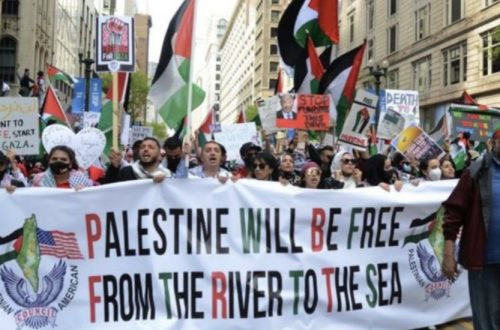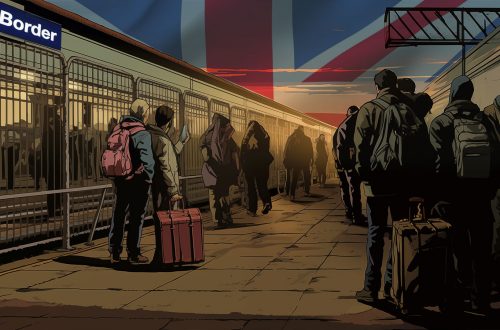This is a cross-post from falsedichotomies.com
On a windy and rainy Friday last autumn, I participated in a Combatants for Peace protest in the northern West Bank, not far from Nablus. The aim was to help local villagers plant trees in an area that had previously been the target of settler attacks. Like all other Combatants for Peace actions, this was unarmed and non-violent (I hope the reason for this tautology will become apparent in the next paragraph). Unfortunately, violence broke out between some local teenagers and the IDF. Stones and tear-gas canisters were soon being swapped between the two (I would not be able to state with any confidence which group used violence first). Before long, some settlers approached, and one or two fired their guns into the air. CFP’s response was unequivocal: the demonstration was called off, and we all withdrew. After buying us knafeh at a local cafe, representatives from the village apologised for the descent into violence.
As Billy Bragg sang, “The only way to disarm is to disarm.” Non-violence means non-violence. Unarmed means unarmed. If you hurl stones, however pathetic and ineffective you claim them to be, you are armed. A protest where people throw stones is not an unarmed protest. This was my argument earlier this week in a Twitfight with Joseph Dana, an American-Israeli journalist who spends much of his time chronicling the protest movement in West Bank villages that have had their land stolen by the Separation Barrier. This is how Dana describes the protests at places like Bilin and Nabi Saleh: “I go to demos on a regular basis. Sometimes they are violent with stones and sometimes they are non-violent without stones. Always unarmed. To my suggestion that someone with a stone could be considered armed, he replied: “If you think a stone in the face of the world’s 4th strongest army is considered ‘armed’ having an honest discussion is out of the question.”
This is like saying that Accrington Stanley do not have an attack because their opponents are Barcelona. Yes, the IDF is much more powerful than the demonstrators it faces each Friday in the West Bank. And I have much sympathy for the predicament faced by the villagers of Nabi Saleh and Bilin, if not for the anti-Zionism of many of their supporters. But I object to the claim that these are non-violent or unarmed protests. After stressing this, Dana unwittingly conceded my point: “If an army invaded your village and arrested your children, Would you throw stones at their armoured jeeps or worse?”
I have never been to Nabi Saleh (which I understand is the most dangerous of the West Bank protests), but I have been to Bilin and Sheikh Jarrah on a number of occasions. From what I saw, Sheikh Jarrah was scrupulously non-violent (and unarmed), and the response of the Border Police stationed there was excessive: I was pushed hard in the back for no apparent reason. I saw red, although luckily I managed to channel my anger towards a choice and little-known English swear-word, rather than a physical response. Each time I have visited Bilin, though, it has never been non-violent, and – contrary to what Dana always says in his tweets – the stones were often thrown before the IDF had fired tear-gas canisters.
The CFP story I described above proves that there is an alternative. The villagers of Bilin and Nabi Saleh are rightly proud of their organisational depth and the endurance of their protests. Because of this, I find it difficult to believe that they cannot do more to stop the stone-throwing. Here is how it could be done: Members of the organizing committees could actively challenge those who gather stones to throw them at the soldiers. Speeches could be given exhorting people to be scrupulously non-violent. The media could be invited to witness all this, and the inevitable political benefits could be reaped.
Another alternative is to admit that these are not non-violent protests. In his latest blog, Dana once again comes close to this position: “Why is it that Palestinians are the only people in the Middle East seemingly not allowed to throw stones at a military regime which oppresses and controls them? Why are Palestinians branded as violent when they use the same tactic which the Egyptian and Tunisian protesters used during their historic revolutions?…Do these youths have a right to throw stones at an invading army?” I am not ideologically wedded to unarmed non-violence, and there is a strong case to be made that, yes, Palestinians do have a right to throw stones at the IDF. But throwing stones at what Dana describes as the ‘fourth strongest army in the world’ is like pulling the wolf’s tail when you can’t kill it. In short, it’s not very clever, at least not strategically. Non-violence is potentially a massive weapon in Palestinian hands; the wise course is to try and realise its potential.
There is a flip-side to this. Non-violence does not necessarily mean just. The Nakba Day march on Israel’s northern borders, for example, was undoubtedly less violent than the West Bank protests, but the cause was far less just. It is impossible for Israel to meet maximalist demands for the Right of Return, and this point must be emphasised even if 500,000 refugees march on Israel’s borders. As a friend put it, the tactics may be a “significant step forward from blowing up pizza parlours and hurling paraplegics from cruise liners,” but – when deployed in favour of the Right of Return – they remain full of contradictions that must be exposed, whether the protesters be unarmed with stones or unarmed without them.


